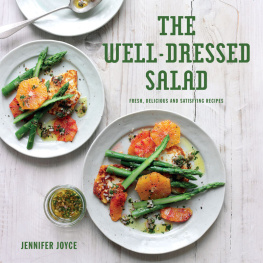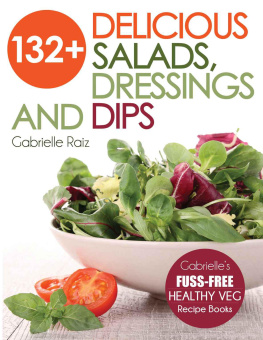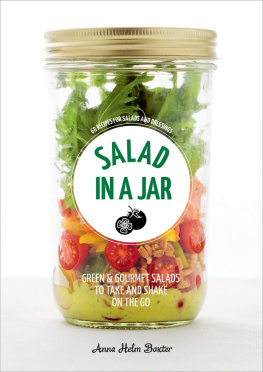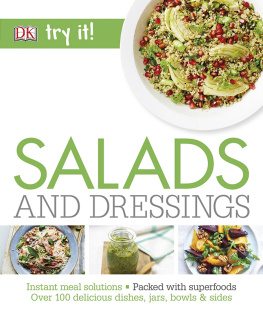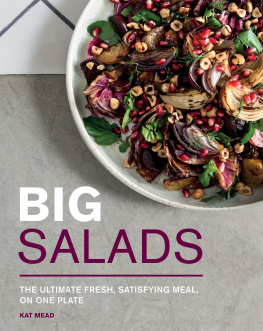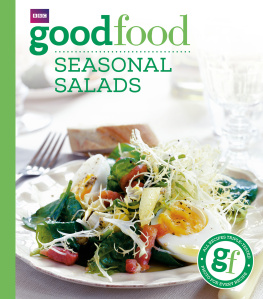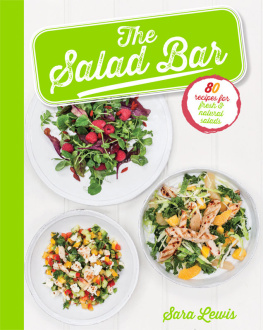Introduction
My obsession with salads began in childhood. I grew up in rural Wisconsin in America, surrounded by lush orchards and fertile farmland. My father, Leo, kept an enormous vegetable garden to help feed our family of 11. Although I cursed the long hours of weeding and laborious end-of-summer bottling, I loved the earthy smell of the garden, its astounding variety and eating juicy, ripe vegetables straight off the vine. My Italian mother, Louise, had to be an efficient household manager, of course, but she was also an artful cook. Delicious food was the one extravagance allowed. Since vegetables were plentiful, we had salads with every meal. Most were simple but intensely good: cucumbers, onions and tomatoes or roasted (bell) peppers dressed with red wine vinegar and olive oil. My favourite part of eating salad came at its pungent end. I would wipe the last vinegary remnants with bread and savour the final tart tastes. Its those mouth-watering memories that spur me to seek out ingredients as exceptional as the produce grown in my fathers garden and transformed at my mothers table.
In the 20 years Ive lived in London, England, my cooking has been influenced by many different cultures and synthesized into what I call modern ethnic food. Although the classes I teach each week might cover Vietnamese or Middle Eastern cooking, Californian cuisine or North African tastes, all my dishes have one thing in common the pursuit of bold, fresh flavours. I am passionate about combining herbs, vinegars and unusual ethnic products to create extraordinary flavours. You wont, for instance, find many mayonnaise dressings here, because flavours should be enhanced, not smothered. I decided to write this book after designing a class on salads and found it difficult to pare down my choices. I love them all, from the great Thai varieties to the perfect Greek salad. I also began to realize how well salads slot into our current lifestyle, reflecting our new awareness about healthy eating. They are wholesome, light and yet full of flavour. A salad is no longer simply a side dish an uninspired bowl of iceberg lettuce slathered with bottled dressing. Its the star of the meal.
My childhood hours in a garden piqued my interest in vibrant salads. But to know the pleasures of good food, you dont need to grow it, you need spectacular new ways to prepare it. Open this book to any page, assemble a few ingredients and eat well!

Salad leaves
Salad leaves (greens) are the backbone for most salads, adding texture, taste and glorious colour. An extra bonus is that they contain an abundance of nutrients and contain few calories. The general rule is the darker the colour, the more nutrients the leaves contain. Most are rich in vitamins A and C, but some such as spinach contain iron. Growing your own salad leaves couldnt be easier, but if green fingers evade you, there is a huge selection available to buy. These days, supermarkets are introducing new lettuces and baby leaves and our excitement can rapidly turn to confusion owing to the myriad varieties. Dont feel overwhelmed use the groupings in this guide to identify the different types.
MILD LEAVES
These sweet and subtle leaves feature in the ubiquitous tossed green salad, but they work equally well in more sophisticated creations. Strong flavours were made for these leaves. Piquant cheeses such as feta, Parmesan and Gorgonzola pair well, along with garlicky vinaigrettes and creamy dressings. Delicate round lettuce (butterhead) is ideal for South-east Asian salads with their bracing chilli-lime dressings. Spinach and cos (romaine) lettuce are the workhorses of this group. Their crisp texture keeps well once theyve been dressed.
Red oak leaf lettuce
Lollo rosso
Lollo bionda
Round (butterhead)
Boston
Iceberg (crisphead)
Lambs lettuce (mche)

